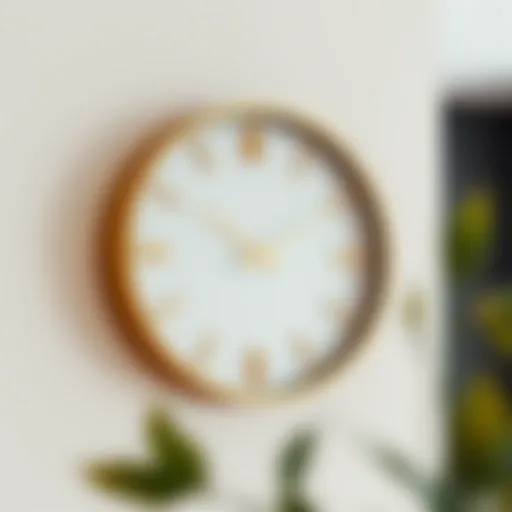Exploring the Versatility of Small End Tables
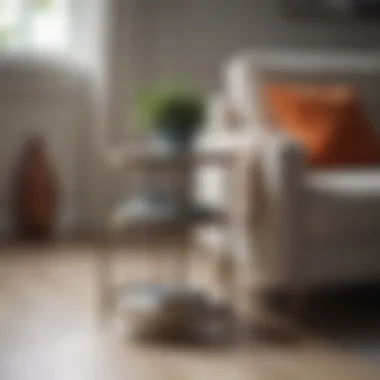

Intro
Small end tables often fly under the radar in interior design, yet their impact on a space can be quite significant. These multifunctional pieces don't just fill empty corners; they can add a touch of style, serve practical purposes, and enhance the overall harmony of a living space. Choosing the right end tables can elevate your home from ordinary to extraordinary.
Their versatility lies not just in their size, but in how they can meld into various design themes—be it modern, rustic, industrial, or eclectic. This article aims to shed light on how two small end tables can transform any room, considering different styles, suitable materials, and maintenance tips that help keep these pieces looking their best.
When contemplating their place in your home, it's essential to understand the nuances of furniture design styles and practical considerations that will serve your needs best. Let’s dive into this exploration and unravel the potential that these unassuming tables hold.
Prelude to Small End Tables
When it comes to furnishing a home, small end tables often play a crucial yet understated role. These versatile furniture pieces serve practical purposes while also contributing to the overall aesthetics of a space. Understanding their significance is key for homeowners, designers, and decor enthusiasts alike.
Defining End Tables
End tables, or occasionally referred to as side tables or accent tables, are typically small tables designed to fit next to seating arrangements like sofas or chairs. Often standing at the same height as armrests, these tables are not just functional; they are the perfect blend of form and utility. Their dimensions generally range from 20 to 30 inches in height, making them accessible for drinks, books, or decorative items without obstructing sightlines.
The design of end tables can vary widely—from minimalist styles featuring clean lines to more ornate options with intricate detailing. A common choice for many is the classic wooden end table, but modern versions might incorporate metal or glass elements, introducing an air of sophistication. Ultimately, the definition of an end table lies in its ability to complement the surrounding decor while providing much-needed surface area where it is often lacking.
Importance in Interior Design
Small end tables may seem inconsequential at first glance, but they hold a distinctive place in interior design that can’t be overlooked. Here are several reasons why these tables are essential:
- Enhancing Functionality: They serve as transitional pieces that enhance the functionality of a room. Whether it's a place to set down a drink or a spot to display family photos, end tables facilitate a more livable space.
- Providing Balance: Strategically placed end tables can help balance the visual weight in a room. For instance, placing them on either side of a sofa can create symmetry, making the space feel coherent rather than chaotic.
- Showcasing Style: Beyond their practical uses, these tables offer an opportunity for personal expression. A well-chosen end table can reflect a homeowner’s tastes—be it contemporary, vintage, or eclectic.
- Supporting Decor: Accessories like table lamps, plants, and books can turn an ordinary end table into a statement piece, further enriching the space.
Moreover, because they come in various shapes and sizes, selecting the right end table can be a way to inject character into a room without overwhelming other design elements.
"The right end table doesn’t just hold objects; it holds the potential to transform the atmosphere of a room."
Functional Roles of Small End Tables
In the realm of interior design, small end tables often serve as unsung heroes, performing multiple functions that extend far beyond mere aesthetics. Whether you're a designer crafting a living space or a homeowner looking to maximize utility, recognizing the importance of these pieces can refine your approach to interior organization and decoration. These tables serve functional roles that can dramatically influence the ambiance and practicality of a room.
Supporting Decor
When it comes to enhancing the overall decor of a living space, small end tables play a pivotal role. Think of them as the supporting actors on a stage; they complement the main furniture, like sofas or armchairs, while bringing their own unique flair. A well-chosen end table can highlight key design features. For instance, a round, glossy black table beside a plush vintage sofa not only adds depth to the arrangement but also contributes a shiny contrast that draws the eye. Moreover, using a table with a distinct texture or interesting shape can also break the monotony of straight lines and flat surfaces commonly found in contemporary designs.
"Furniture should always be functional, but can also provide beauty and product personalization at the same time."
In terms of decor, consider styling these tables with artful pieces such as vibrant flowers, a decorative bowl, or even a stack of your favorite books. These elements not only spruce up the table but can also offer a window into your personality and interests. With a little creativity, they invite guests to engage, sparking conversations that can flow seamlessly amidst your chosen environment.
Storing Essentials
Storage is another vital function of small end tables that cannot be overlooked. Often underestimated, these compact tables can house numerous everyday items without taking up too much real estate. Think about the common scenario of a living room – a cozy throw blanket, magazines, or remote controls can easily clutter the floor or other surfaces. By design, an end table can contain these essentials neatly. Look for tables with shelves or drawers to offer further practicality. This hidden storage option keeps your space organized and ensures that everything is within reach when you need it most.
Moreover, a small end table can shine in bedrooms as a nightstand. Here, the table can do double duty as a spot for essential items like reading glasses, a sleep mask, or even a charging station for your devices. It's all about integrating functionality into your layout while ensuring it aligns with your aesthetic preference.
Serving Functions
Last but not least, small end tables are quite valuable when it comes to their serving functions. Serving trays, drinks, snacks, or even a warm cup of coffee can be conveniently placed on these surfaces when you entertain guests. Thus, they transition effortlessly from a stylish decor piece to a functional serving station.
Furthermore, their mobility offers added convenience. An end table can easily be moved to accommodate guests or create pathways for easier movement within a room. Imagine hosting a lively gathering where guests leisurely place their drinks down on the end tables, creating a casual yet elegant atmosphere. With the right design and placement, these tables become integral to hosting and enhancing social interactions.
In summary, small end tables are much more than simple furnishings. They support decor, provide essential storage, and serve multiple functions that can ease the hustle and bustle of everyday life. By tapping into their versatility, designers, homeowners, and decor enthusiasts can elevate their living spaces significantly.
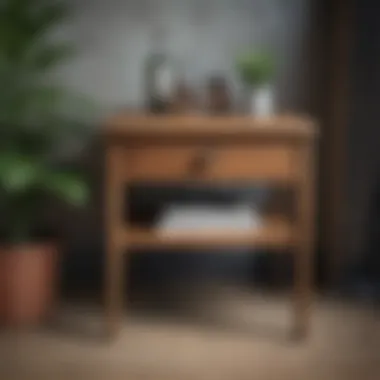

Selecting the Right End Tables
Choosing the right end tables involves more than just picking what looks good. It’s about understanding how these small pieces fit into your space and serve your needs. The right end tables not only offer support for decor but also blend seamlessly with your interior style. As you consider what type to buy, it’s essential to weigh different factors that can impact both functionality and aesthetics. From the size that best suits your room to material options that match your lifestyle, each choice marks a significant step towards enhancing your living area.
Considerations for Size
When it comes to size, the first thing to keep in mind is the space where the end tables will sit. It’s essential that they neither dwarf nor get lost among your other furnishings. Typically, the height of end tables should be similar to the armrest of your sofa or chair, ensuring easy access to items placed on them. A general guideline is that they should be about 1-2 inches lower than the seating surface.
Plus, consider the width. If your living area is cramped, narrower tables can help maintain flow. If you’ve got more room to breathe, wider tables could complement the space better while adding visual balance.
Material Choices
Wood Finishes
Wood finishes present warmth and a certain character that other materials may lack. Depending on the type of wood selected, the finish can range from sleek and modern to rustic and worn. For example, oak or walnut might lean toward a more traditional vibe, while bamboo can offer an eco-friendly twist.
The key characteristic of wood is its durability; it can withstand years of regular use if treated properly. However, be mindful of potential water damage from spills. To preserve its beauty, regular maintenance with polish is typically recommended.
Metal Accents
Metal accents bring a touch of elegance and modernity to end tables. Stainless steel or wrought iron often shine in a contemporary setting, adding a stylish contrast to softer materials like wood or fabric. They’re respected for their sturdiness, making them a favored choice in high-traffic areas.
One unique feature is their sleek appearance, which can maintain an open feel in smaller spaces. Still, the downside is that metal can get cold or hot based on the surrounding temperature, which might not be comfortable for all users.
Glass Surfaces
Glass surfaces present a fresh and light aesthetic. They create the illusion of space, making them a solid option for small or cluttered areas. The transparency allows for a versatile look that can adapt to various designs while letting the underlying furnishings shine through.
A critical characteristic of glass is its ease of cleaning—most spills can be wiped away in seconds. Nevertheless, it’s important to be cautious with sharp objects, as glass can easily scratch or crack when treated carelessly, which may present durability concerns in busy households.
Style Compatibility
Modern
Modern end tables emphasize clean lines and minimal ornamentation, fostering a streamlined appearance. Materials like glass and light metals often play a key role in achieving this sought-after look. Many find modern tables appealing for their ability to match multiple styles without overpowering them. However, they can sometimes lack the warmth provided by traditional designs, making them less inviting in cozy settings.
Traditional
Traditional end tables often feature intricate details and are usually made from rich woods featuring dark or mahogany finishes. They represent a kind of timelessness and can warm up any room, bringing a sense of history with them. While these pieces may lack versatility in modern settings, they resonate well with classic decor enthusiasts and can readily enhance the charm of a space.
Eclectic
Eclectic end tables cater to those who appreciate variety and creativity in their decor. Such tables may meld materials, colors, and designs, allowing them to act as its pieces of art. Their unique combinations can engage conversation while providing functional surfaces.
On the flip side, their sporadic style might pose a challenge for homeowners aiming for a unified aesthetic. It boils down to balancing singularity and coherence in your design approach.
Design Styles for End Tables
In the realm of interior design, small end tables are the unsung heroes that often go unnoticed until you begin contemplating the design styles they embody. These tables don’t just serve a utilitarian purpose; they can meld seamlessly into the decor, making a statement about personal taste and enhancing the overall atmosphere of a room. Exploring various design styles for end tables allows homeowners and decorators to align these pieces with their vision, whether aiming for sleek modernity, rustic warmth, or industrial edge.
Choosing the right design style not only accents the surrounding furnishings but also addresses practical needs that arise within diverse spaces. Here are a few crucial aspects to consider:
- Aesthetic Alignment: End tables should complement the overall style of a room, making them essential in design cohesion.
- Functional Versatility: Different styles may offer unique storage or display solutions, adapting to the way individuals use their spaces.
- Material Synergy: The materials used—be it wood, metal, or glass—can dramatically alter both the visual weight and the thematic overtone of the room.
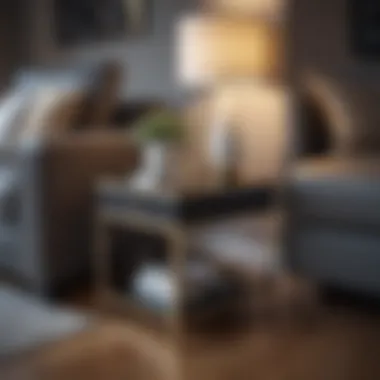

Let’s delve into three prominent styles that can breathe life into two small end tables, making them more than just an afterthought.
Minimalist Approaches
In a world often overwhelmed by clutter, minimalism offers a refreshing take. Minimalist end tables embrace simplicity, focusing on clean lines and functional form. They are often made from light materials and have an unobtrusive presence that effortlessly blends with the environment.
Key Features of Minimalism:
- Simple and uncluttered design
- Neutral, muted colors like whites, greys, and beiges
- Materials such as light wood or acrylic glass that suggest transparency
Using minimalistic end tables allows you to maintain a sense of spaciousness while providing necessary utility in a sleek package. They are particularly effective in small rooms where every piece needs to count.
Rustic Charm
On the flip side, rustic end tables boast a warmth and character that can turn a cold space into a cozy haven. Often constructed from reclaimed wood or featuring wrought iron, these tables reflect craftsmanship and a connection to the past. They tell a story through their textures and imperfections.
Characteristics of Rustic Design:
- Textured surfaces and weathered finishes
- Earthy tones—think browns, greens, and deep reds
- Organic shapes that mimic nature’s forms
Incorporating rustic charm through end tables can bring a homey feel to any area, making it inviting and comforting, especially in living rooms or bedrooms where relaxation is key. They can double as a display space for personal artifacts or books, reinforcing the character they contribute to.
Industrial Aesthetics
Industrial design takes a more edgy route, drawing inspiration from factories and warehouses. With a mix of raw materials and modern elements, end tables in this style often exhibit an unfinished look with exposed metal frames and distressed wood. They share a bold presence that can hold its own in a room.
Essentials of Industrial Style:
- Utilitarian forms with an emphasis on function
- Combination of metal and reclaimed wood or concrete
- Monochromatic color schemes with splashes of color from accessories
Adding industrial end tables to your decor can create a striking focal point, especially in urban settings or modern decors. They are versatile enough to serve as accent tables, or to support various decorative elements like oversized lamps or stacks of magazines.
"The right end table can transform a mundane corner into a stylish vignette, enriching the narrative of your living space."
In summary, the style of end tables—whether they lean towards minimalist, rustic, or industrial—greatly impacts the home's tone and functionality. By choosing the right design, homeowners can not only fulfill practical needs but also create a cohesive and inviting environment.
Creative Uses in Living Spaces
When discussing the role of small end tables in various living spaces, it’s crucial to highlight their adaptability and the unique functionalities they offer. These tables are not merely decorative pieces; they serve as vital tools in enhancing the overall appeal and efficiency of a space. From traditional roles to innovative placements, small end tables can significantly impact the feel and functionality of different areas in a home.
Positioning in Living Rooms
Next to Sofas
Placing an end table next to a sofa is a classic move that almost everyone has seen or experienced. This positioning creates a convenient spot for placing drinks, books, or remote controls, thereby keeping essentials within arm's reach. An end table situated by a sofa offers a sense of balance, both visually and functionally. It can be a stylish accent that adds to the overall decor theme.
One noteworthy characteristic of these tables is their height. Ideally, they should be level with the arm of the sofa. This alignment not only enhances function but also creates a cohesive look. The ability to slide a small lamp or a stack of coasters onto the table makes it a popular choice.
However, one should consider the size of the sofa and the surrounding area carefully. If the table is too large, it may overwhelm the space; if it’s too small, it could become impractical.
Between Chairs
Positioning an end table between chairs can create a cozy and inviting atmosphere, especially in a conversational nook or a reading corner. This arrangement allows easy access to drinks or snacks while seated and invites informal social interactions. It serves as a bridge — literally and figuratively — connecting different seating elements in the room.
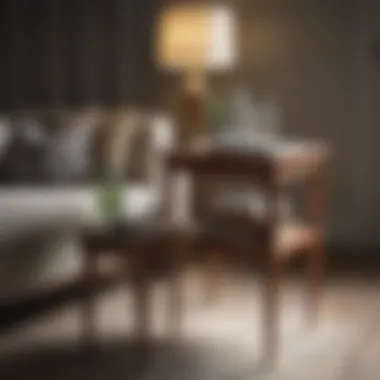

The key characteristic of a table placed between chairs is its ability to facilitate conversation. With the right design, it can become a focal point that ties the seating together. Whether it’s an intricate wooden piece or a sleek glass design, the end table can charm its way into the heart of living spaces.
On the downside, one needs to ensure that the chairs are within comfortable reach of the table. If not, it can become an afterthought rather than a functional furniture piece. Another critical point is the durability of the table. If it's not built well, it may not withstand the daily wear and tear.
Functionality in Bedrooms
Nightstands
Nightstands are perhaps the most recognized use of end tables in bedrooms. By calling it just a nightstand, it can understate its importance. This piece of furniture serves not only as a bedside table for lamps, but also as storage for personal items like books, medications, and even tech gadgets. The convenience of having these items close at hand cannot be overstated — it's all about functionality while maintaining a clean look.
A well-chosen nightstand can complement the style of a bedroom quite effectively. From contemporary designs to rustic finishes, the options are aplenty. The unique feature here is storage. The presence of drawers can help keep clutter at bay. But, one must keep in mind that the height and depth of the nightstand should align with the bed; otherwise, it could look out of place.
Display Surfaces
Using small end tables as display surfaces opens a door to creativity and personalization. They can showcase cherished objects, photographs, or even small greenery. This aspect allows homeowners to express their style without overwhelming the space.
What's great about display surfaces is that they do not have to sacrifice practical function for aesthetics. Compact sizes allow for versatile decorating without crowding out the room. However, one must be cautious — having too many ornaments can look cluttered rather than carefully curated.
Versatility in Home Offices
The versatility of small end tables really shines in home office settings. They can serve multiple purposes from being a spot for your coffee during work sessions to a temporary holder for documents or supplies, making them invaluable in a space where efficiency is key. The coherent blend of style and utility makes them a worthy addition to any home office. Whether used as additional surface areas or functional storage, these tables can dramatically improve workspace organization and maintain a polished look.
Maintaining Small End Tables
In the realm of interior design, maintaining small end tables is an often overlooked yet crucial aspect. These pieces do more than simply hold decor or drinks; they represent a part of your overall living environment. A well-maintained end table not only extends the lifespan of the furniture but also keeps your space looking polished and inviting. Understanding the significance of proper care lets you enjoy their functionality and aesthetic appeal for years to come.
Cleaning Techniques
Regular cleaning is vital to preserve the condition of small end tables. Here are some efficient cleaning techniques that are easy to follow:
- Dusting: Start by using a soft cloth or microfibre duster to eliminate dust and debris. It's best to do this weekly, as dust can accumulate quickly, clinging to any decorative items or surfaces.
- Gentle Cleansing: For tougher stains or buildup, opt for a mild soap mixed with warm water. Dampen a cloth and gently wipe down the surface, avoiding any harsh chemicals that could damage finishes. Always remember to test any cleaning solution on an inconspicuous area first!
- Conditioning Wood: If you have wooden end tables, applying a wood conditioner or polish every few months can refresh the surface while providing a protective layer against moisture and spills.
"A little care goes a long way. Not only does it keep your table looking great, but it also maintains its structural integrity and functionality."
In addition to regular cleaning, it is beneficial to stay alert for any signs of wear and tear. Small scratches or dents can detract from the table's overall appearance.
Preventative Care
Preventative care is the unsung hero in furniture maintenance, particularly for small end tables. Taking some simple precautions can help avoid mishaps that may lead to costly repairs or replacements:
- Use Coasters: Always place coasters under drinks to protect surfaces from rings and spills. This is especially critical for wood or lacquered surfaces, where damage can be permanent.
- Avoid Direct Sunlight: Position your end tables away from direct sunlight. Exposure can cause fading and warping over time, particularly for certain materials like wood and fabric.
- Limit Heavy Loads: Try not to overload these tables with too many items. Overstacking can lead to unwanted pressure, risking instability or even breakage.
- Inspect Regularly: Conduct regular checks for any loose screws or unstable legs. Tightening any loose components, when discovered early, can prevent more pronounced issues from developing down the line.
In essence, maintaining small end tables is a simple yet vital aspect of home decor. Enforcing proper cleaning techniques alongside preventative measures not only enhances the appearance but also increases their utility, ensuring these versatile furniture pieces continue to shine in your interior design for years.
The End: Elevating Spaces with End Tables
The role of small end tables in interior design is often understated, yet their impact can be profound. These pieces of furniture do more than simply offer support for a lamp or a drink; they serve as vital components that can enhance the overall design aesthetic and function of a room. By integrating end tables into various living spaces, we can achieve a balance between practicality and style, creating atmospheres that feel both inviting and organized.
One of the most significant elements highlighted throughout this discussion is versatility. Small end tables are remarkably adaptable, fitting seamlessly in various settings, whether they are positioned next to a plush sofa, serving as nightstands in a cozy bedroom, or even doubling as a display surface in a hallway. This functional flexibility allows homeowners and designers to maximize their space effectively without sacrificing style.
Moreover, the choice of materials plays a crucial role in the design impact. From the warmth of a beautifully finished wood to the sleekness of metal accents or the elegance of glass surfaces, the materials can significantly alter the mood of a space. Choosing the right end table not only complements existing decor but can also become a focal point that stimulates conversation.
It's also important to consider the influence of style compatibility. The design of an end table should harmonize with the room's overall theme. Whether your style is minimalist, rustic, or industrial, there's always a small end table out there that will fit right in, enhancing what’s already there and elevating the visual experience of the space.
"A well-placed end table can pull a room together, making it feel complete rather than chaotic."
Ultimately, maintaining these functional beauties can prolong their life and keep them looking their best. Regular cleaning and preventative care are essential practices that ensure these furnishings continue to enhance our homes. Moreover, the attention given to their upkeep reflects a homeowner's commitment to both aesthetics and functionality, making end tables not just furniture but essential parts of a cohesive design narrative.
As we wrap up this exploration, it's clear: small end tables are more than an afterthought in home design. They are a strategic addition that can elevate spaces, balancing beauty and utility in a way that few other furnishings can. Whether you're a designer, retailer, homeowner, or DIY enthusiast, understanding the pivotal role of these small tables can enrich your space, making it uniquely yours.













